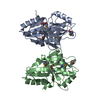+Search query
-Structure paper
| Title | Structural underpinnings of nitrogen regulation by the prototypical nitrogen-responsive transcriptional factor NrpR. |
|---|---|
| Journal, issue, pages | Structure, Vol. 18, Issue 11, Page 1512-1521, Year 2010 |
| Publish date | Nov 10, 2010 |
 Authors Authors | Goragot Wisedchaisri / David M Dranow / Thomas J Lie / Jeffrey B Bonanno / Yury Patskovsky / Sinem A Ozyurt / J Michael Sauder / Steven C Almo / Stephen R Wasserman / Stephen K Burley / John A Leigh / Tamir Gonen /  |
| PubMed Abstract | Plants and microorganisms reduce environmental inorganic nitrogen to ammonium, which then enters various metabolic pathways solely via conversion of 2-oxoglutarate (2OG) to glutamate and glutamine. ...Plants and microorganisms reduce environmental inorganic nitrogen to ammonium, which then enters various metabolic pathways solely via conversion of 2-oxoglutarate (2OG) to glutamate and glutamine. Cellular 2OG concentrations increase during nitrogen starvation. We recently identified a family of 2OG-sensing proteins--the nitrogen regulatory protein NrpR--that bind DNA and repress transcription of nitrogen assimilation genes. We used X-ray crystallography to determine the structure of NrpR regulatory domain. We identified the NrpR 2OG-binding cleft and show that residues predicted to interact directly with 2OG are conserved among diverse classes of 2OG-binding proteins. We show that high levels of 2OG inhibit NrpRs ability to bind DNA. Electron microscopy analyses document that NrpR adopts different quaternary structures in its inhibited 2OG-bound state compared with its active apo state. Our results indicate that upon 2OG release, NrpR repositions its DNA-binding domains correctly for optimal interaction with DNA thereby enabling gene repression. |
 External links External links |  Structure / Structure /  PubMed:21070950 / PubMed:21070950 /  PubMed Central PubMed Central |
| Methods | EM (single particle) / X-ray diffraction |
| Resolution | 2.5 - 25.0 Å |
| Structure data |  EMDB-5221:  EMDB-5222:  PDB-3nek: |
| Chemicals |  ChemComp-GOL:  ChemComp-HOH: |
| Source |
|
 Keywords Keywords |  structural genomics / unknown function / PSI-2 / structural genomics / unknown function / PSI-2 /  Protein Structure Initiative / New York SGX Research Center for Structural Genomics / NYSGXRC Protein Structure Initiative / New York SGX Research Center for Structural Genomics / NYSGXRC |
 Movie
Movie Controller
Controller Structure viewers
Structure viewers About Yorodumi Papers
About Yorodumi Papers





